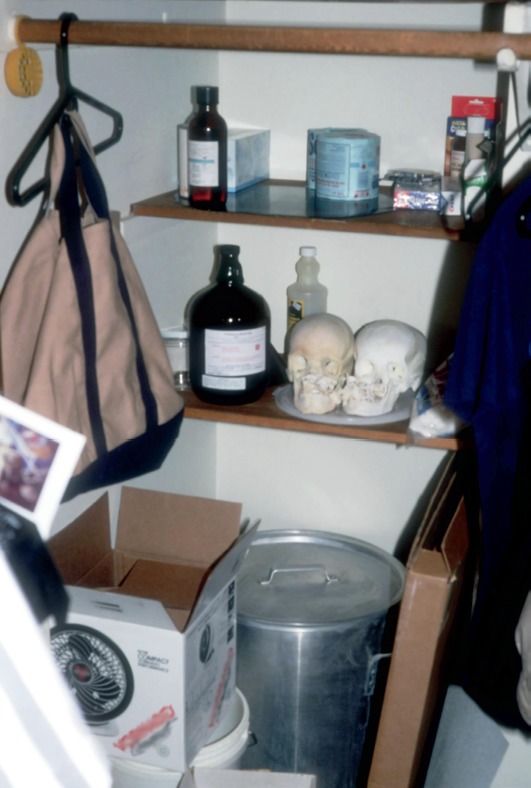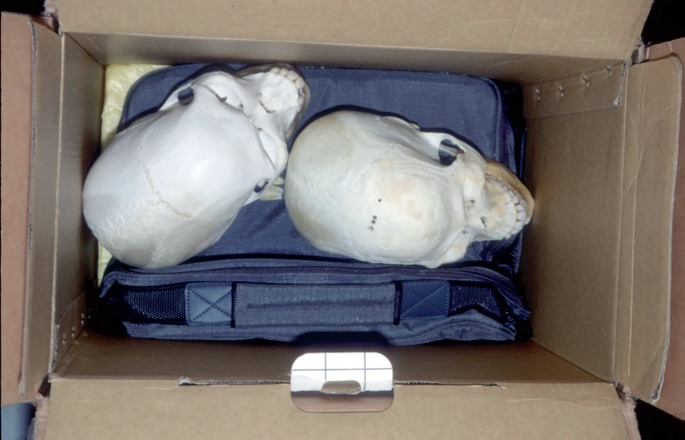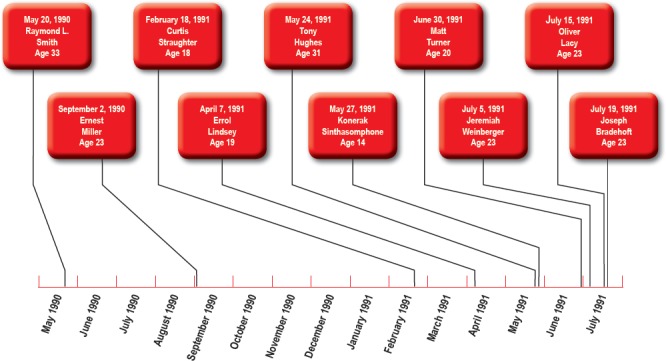Abstract
Disasters are commonly experienced as major devastating events that exceed the resources of an agency to respond, with effects emanating throughout a community or region. There are, however, those events that are more measured, more subtle, and with few actual deaths, which still distract investigators from their daily duties and routines and project long lasting and crippling effects to a community or nation. Disasters can occur from natural forces or be the result of human activity. Most forensic pathologists who practice over a significant time will encounter one or the other types of disaster, sometimes more than a few. In my own career, I have witnessed large-scale disasters, such as hundreds of deaths occurring as the result of a major heat wave, to small-scale disasters such as factory explosions or small airplane crashes at sea—each with their own challenges. In addition to the extent of the initial disaster, many require the detailed, exhaustive evidentiary recovery and examination of a crime scene. The Jeffrey Dahmer case, although only involving 11 actual victims, required a major disaster response, and continues to influence and affect a community over 25 years later.
Keywords: Forensic pathology, Jeffrey Dahmer, Serial murder, Serial killer
Introduction
Many individuals think of disasters as large scale events that result in numerous fatalities; however, disasters can occur on a smaller scale and still have profound effects on the community at large and, in particular, the investigators responsible for dealing with the aftermath. The social science literature suggests that disasters, in addition to demonstrating a community's preparedness, also reflect the realities of social isolation, economic inequalities, and failures of political will (1). The Jeffrey Dahmer case, although only involving 11 actual victims, required a major disaster response, exposing the capacity to respond to and investigate a major crime that continues to influence and affect a community over 25 years later. The Jeffrey Dahmer case presented unusual dynamics due to the nature of the murders, intense media coverage, and sexual orientation of many of the victims. The majority of the victims were homosexual and had been reported missing by their families for many weeks to months. The media published the grim details of the murders and methods of disposal. The trial was followed closely and watched around the world.
Discussion
The Scene
On July 23, 1991, personnel from the Milwaukee Police Department encountered a naked man in handcuffs running in the street. The individual escorted the officers to Jeffrey Dahmer's apartment, where the victim alleged he had been drugged and assaulted. After officers gained access to the residence, Dahmer was quickly taken into custody. The victim showed the officers the decapitated head of male in the refrigerator he had previously seen and a full criminal investigation commenced (2).
Personnel from the Milwaukee County medical examiner's office responded to the scene. Per established routine, medical examiner personnel worked closely with the Milwaukee police department independently photographing and documenting the scene and its evidence. Within the restricted crime scene, the dining room area contained recently purchased hardware implements such as tape, a hammer, handsaw, and an electrical drill in the bedroom. They also encountered numerous human body parts including seven skulls, three of which were painted. There were four intact human heads, one dissected postcranial skeleton in a portable freezer, and three partially skeletonized bodies in a 55-gallon drum. The freezer compartment of the refrigerator contained what was later identified as a human heart and large muscle filets packaged in plastic bags. Other evidence, including large boxes of muriatic acid, degreasing solvents, Polaroid photographs of victims (both alive and in various states of dissection), desiccated male genitals, and hands were recovered (Image 1).
Image 1.

Kitchen and dining area of the apartment shows the muriactic acid and degreaser agents. Polariod photos of victims are on top of the portable freezer. The kitchen contained no food material.
Scene photographs were essential, not only for the documentation of the initial scene, but in the continual review and analysis of the evidence over time. By their very nature, disasters have a way of dulling the senses of even the most experienced investigators, creating a “fog-of-war,” where the ability of the investigator to comprehend the meaning and significance of evidence, including time and space, can be clouded. For example, the kitchen had no food material—only a can of Crisco grease—which supported later allegations of cannibalism. There was a large art deco table with a large fish tank. Photographs found elsewhere in the apartment showed Dahmer had documented numerous victims that had been posed on the table prior to, during, and after dismemberment (Image 2). Desiccated male genitalia, scalp hair, hands, and skulls supported the fact that they were retained as “souvenirs” in a typical pattern of an organized serial killer (Image 3) (3).
Image 2.

Dahmer recreated the photograph over the black table by posing his victims on the table and taking their picture for souvenirs.
Image 3.

The hall closet containing cholorform and ether bottles Dahmer used to sedated and kill his victims. Note the cleaned skulls and cooking pot that contained human body parts as souvenirs.
The evaluation of the scene allowed investigators to establish methods of death, begin the preliminary identification process, and demonstrate the deteriorating mental capacity of the assailant. Forensic pathologists assisted with the identification, established the cause of death, and documented injuries that allowed investigators to question Dahmer on various injuries he inflicted upon his victims. Anthropological examination assisted with the identification and also resulted in the establishment of victim profiles.
Autopsy Findings
Forensic pathologists initially analyzed the body parts and skeletons recovered at the scene. The portable freezer contained, in addition to a decapitated frozen head, defleshed bones and 3480 g of tissue cut in to irregular, square pieces not exceeding 15 cm. The 55-gallon drum contained four decomposing skeletons, which could be approximated using the variable dissection planes of dismemberment. The cleaned, postcranial skeleton could be matched to a skull by the unique atlanto-occipital joints identified by the anthropologist.
The paint was removed from the defleshed skulls, which revealed the presence of holes drilled into the frontal regions of the skull. The skulls contained two, three, and four holes. Examination of the frozen skull revealed the presence of a single hole surrounded by faint, periosteal hemorrhage. The cranium was opened and the brain examined. There was a hemorrhagic wound track through the brain that demonstrated microscopic, organizing inflammation and endothelia inflammation a distance from the wound. These findings indicated a healing injury of some duration inflicted while the victim was alive.
These autopsy findings were communicated to Dahmer through the detective. Dahmer reluctantly admitted that he had attempted to create “zombie sex-slaves” by drilling the skulls and injecting acids and other materials (4). It appeared to investigators that Dahmer was experimenting to obtain optimal results by “lobotomizing” his victims with a series of a decreasing number of drill holes (Image 4).
Image 4.

Two cleaned skulls, one with four drilled holes used to infuse acid into the brain. Below the skulls is a briefcase containing Polaroid pictures of all his vicitms.
Psychological Analysis
The detailed scene investigation and autopsy examination allowed for evaluation of Dahmer's motives, methods, and mental state over the months leading to his capture. In this unique situation, Dahmer freely discussed his role in the murders with law enforcement and provided a valuable resource for collaboration of scene, anthropological, and autopsy findings to forensic pathologists, forensic psychiatrists, and law enforcement personal during the investigation. Scene investigation and autopsy analysis of the bodies provided prosecutors with detailed evidence of the motives and psychological state of Dahmer during the course of a death spree that lasted nine months.
A forensic psychiatrist constructed Dahmer's psychological profile characterized by a destructive behavior in which his collection of fetishistic memorabilia provided an expression of his deep ambivalence and mixed hostility towards his victims. Frustrated with his sexual immaturity and continual rejection, Dahmer channeled his hostility into a sadistic sexual behavior characteristic of the psychopathology of a serial killer (5).
Dahmer was a controlled, organized serial killer who manifested all of the phases of a serial killer. He selected his victims by trolling local bars. He posed his victims before, during, and after death. He retained souvenirs of his victim's body parts and photographs. The accelerated rate of the killings, accumulation of bodies, and need for additional storage containers demonstrated that Dahmer was becoming increasingly disorganized psychologically and in his methods of killing and disposal (Figure 1).
Figure 1.

The chronology of the murders demonstrates an increasing frequency and loss of control. Victims were eight black males, one Asian male, and one White male, ages 14-33.
Identification
Unlike some major disasters, those of a more limited nature may have an established manifest of names and identities. Antemortem dental records, fingerprints, and other identifying records were rapidly recovered or already on file. Dahmer's retention of some of the victims' identification at the scene facilitated the process. Of the 11 victim remains recovered from Dahmer's apartment, four could be identified with fingerprints and all of the identifications were confirmed by dental comparison. In 1991, the use of DNA for routine identification was years away for the average medical examiner office. Nonetheless, the victims were all identified within three days using a combination of fingerprints and dental records readily available to the investigators (4).
The majority of victims were African-American males in their 20s and 30s. Anthropological examination confirmed similarities in craniofacial and stature measurements, which suggested that Dahmer had a fetish and desired a certain body type (5).
Media and Family Relations
In addition to the usual crush of media attention that accompanies a mass casualty incident, two days into the investigation, local citizens accused the Milwaukee Police Department of criminal indifference by allowing one of the victims, 14-year-old Konarack Sinthasomaphon, to be returned to Dahmer and later murdered. Dahmer had convinced police that the dispute was over a homosexual lovers' quarrel and that Konarack was 19-years-old. The citizens group charged it was the officer's insensitivity to the gay community that allowed Dahmer to escape arrest and continue his killing spree. This only added to the chaos of the disaster, distraction of investigators, and allegations of neglect of law enforcement (6).
Conclusion
In addition to the overwhelming chaos disaster investigators routinely confront, in the Jeffrey Dahmer case, they also encountered a complex crime scene. A unique factor in the investigation was Dahmer's willingness to cooperate with law enforcement investigators in answering questions related to the manner and methods of killing, disposal of the bodies, and artifacts noted at the scene and autopsy.
The multidisciplinary investigation that followed provided investigators with a number of conclusions that permitted the successful prosecution and conviction of Jeffrey Dahmer. Dahmer drugged, strangled, and dismembered his victims following his use of “chemical” restraints. Forensic autopsies demonstrated the organized methods of death, experimental lobotomies, postmortem dissection, and disposition. Anthropological analysis suggested Dahmer was psychologically attracted to a certain anthropometric body type. He experimented with a method of injecting caustic material in the brains of his victims to sedate and pacify them into helpless “zombies.” Materials recovered from the science confirmed the methods of an “organized” serial killer with souvenir taking to enhance sexual pleasure. An examination of the chronology of death revealed a pattern of increasing frequency of the murders and the impression that Dahmer was becoming increasingly disorganized and out of control (7).
Limited mass casualty incidents generally do not require the use of state and federal disaster resources and can be handled at a local level. The identities of the victims are usually known and quickly confirmed. However, even the most limited incident carries with it a search for the causes and punishment of those responsible. In some cases, comingling of the remains of victims and those responsible may add to the anguish of the families. In any operation, investigators encounter numerous obstacles in processing a disaster. Concerns and demands of families, allegations of mismanagement, intense and urgent media requests, and an unrealistic expectation add to the stress of managing the disaster. In the Dahmer case, allegations of police indifference and threatened lawsuits only added to the political and social pressure on the investigation. In many disasters, including those with a limited number of victims, investigators face challenges in resources, personnel, expertise, and patience.
No matter the size or extent of a disaster, the forensic pathologist must anticipate that the death investigation may have criminal and civil implications requiring detailed death investigation. Cooperation among investigating agencies is a must for proper and rapid identification, determination of cause and manner of death, disposition of the remains to the family, and to manage an appropriate media response.
Footnotes
ETHICAL APPROVAL
As per Journal Policies, ethical approval was not required for this manuscript
STATEMENT OF HUMAN AND ANIMAL RIGHTS
This article does not contain any studies conducted with animals or on living human subjects
STATEMENT OF INFORMED CONSENT
No identifiable personal data were presented in this manuscsript
DISCLOSURES & DECLARATION OF CONFLICTS OF INTEREST
The authors, reviewers, editors, and publication staff do not report any relevant conflicts of interest
FINANCIAL DISCLOSURE The authors have indicated that they do not have financial relationships to disclose that are relevant to this manuscript
References
- 1.Keller R.C.. Fatal isolation: the devastating Paris heat wave of 2003. Chicago: University of Chicago Press; c2015. Introduction; p. 10–1. [Google Scholar]
- 2.Cuprisin T.. Demonstrators defend suspended officers. Milwaukee Journal. 1991. Aug 5; A6. [Google Scholar]
- 3.Knocke E.. Dahmer details deaths. Milwaukee Journal. 1991. Jul 25: A1, 11. [Google Scholar]
- 4.Jentzen J. Palermo G. Johnson L.T. et al. Destructive hostility: the Jeffrey Dahmer case. A psychiatric and forensic study of a serial killer. Am J Forensic Med Pathol. 1994. Dec; 15(4): 283–94. PMID: 7879770. 10.1097/00000433-199412000-00002. [DOI] [PubMed] [Google Scholar]
- 5.Bennett K.. Victim selection in the Jeffrey Dahmer slayings: an example of repetition in the Paraphilias? J Forensic Sci. 1993. Sep; 38(5): 1227–32. [Google Scholar]
- 6.State of Wisconsin v. Jeffrey Dahmer, Case F-912542, 1992. Trial testimony of Dr. George Palmero MD. [Google Scholar]
- 7.Swat A. Riepenhoff J.. The Jeffrey Dahmer files [motion picture]. Milwaukee: Good Credit Productions; 2012). 76 min. [Google Scholar]


